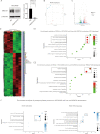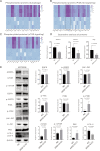ARID1A deficiency reverses the response to anti-PD(L)1 therapy in EGFR-mutant lung adenocarcinoma by enhancing autophagy-inhibited type I interferon production
- PMID: 36229854
- PMCID: PMC9558404
- DOI: 10.1186/s12964-022-00958-5
ARID1A deficiency reverses the response to anti-PD(L)1 therapy in EGFR-mutant lung adenocarcinoma by enhancing autophagy-inhibited type I interferon production
Abstract
Introduction: EGFR mutations in non-small cell lung cancer (NSCLC) are associated with a poor response to immune checkpoint inhibitors (ICIs), and only 20% of NSCLC patients harboring EGFR mutations benefit from immunotherapy. Novel biomarkers or therapeutics are needed to predict NSCLC prognosis and enhance the efficacy of ICIs in NSCLC patients harboring EGFR mutations, especially lung adenocarcinoma (LUAD) patients, who account for approximately 40-50% of all NSCLC cases.
Methods: An ARID1A-knockdown (ARID1A-KD) EGFR-mutant LUAD cell line was constructed using lentivirus. RNA-seq and mass spectrometry were performed. Western blotting and IHC were used for protein expression evaluation. Effects of 3-MA and rapamycin on cells were explored. Immunofluorescence assays were used for immune cell infiltration examination.
Results: ARID1A expression was negatively associated with immune cell infiltration and immune scores for ICIs in LUAD with EGFR mutations. In vitro experiments suggested that ARID1A-KD activates the EGFR/PI3K/Akt/mTOR pathway and inhibits autophagy, which attenuates the inhibition of Rig-I-like receptor pathway activity and type I interferon production in EGFR-mutant LUAD cells. In addition, 3-MA upregulated production of type I interferon in EGFR-mutant LUAD cells, with an similar effect to ARID1A-KD. On the other hand, rapamycin attenuated the enhanced production of type I interferon in ARID1A-KD EGFR-mutant LUAD cells. ARID1A function appears to influence the tumor immune microenvironment and response to ICIs.
Conclusion: ARID1A deficiency reverses response to ICIs in EGFR-mutant LUAD by enhancing autophagy-inhibited type I interferon production. Video Abstract.
Keywords: ARID1A; Autophagy; EGFR-mutant lung adenocarcinoma; Immunotherapy; Type I interferon.
© 2022. The Author(s).
Conflict of interest statement
The authors declare no competing interests.
Figures






Similar articles
-
Multiomics analysis revealed the mechanisms related to the enhancement of proliferation, metastasis and EGFR-TKI resistance in EGFR-mutant LUAD with ARID1A deficiency.Cell Commun Signal. 2023 Mar 3;21(1):48. doi: 10.1186/s12964-023-01065-9. Cell Commun Signal. 2023. PMID: 36869329 Free PMC article.
-
Single-cell transcriptome analysis revealed a suppressive tumor immune microenvironment in EGFR mutant lung adenocarcinoma.J Immunother Cancer. 2022 Jan;10(2):e003534. doi: 10.1136/jitc-2021-003534. J Immunother Cancer. 2022. PMID: 35140113 Free PMC article.
-
ILT4 inhibition prevents TAM- and dysfunctional T cell-mediated immunosuppression and enhances the efficacy of anti-PD-L1 therapy in NSCLC with EGFR activation.Theranostics. 2021 Jan 19;11(7):3392-3416. doi: 10.7150/thno.52435. eCollection 2021. Theranostics. 2021. PMID: 33537094 Free PMC article.
-
ARID1A serves as a receivable biomarker for the resistance to EGFR-TKIs in non-small cell lung cancer.Mol Med. 2021 Oct 29;27(1):138. doi: 10.1186/s10020-021-00400-5. Mol Med. 2021. PMID: 34715776 Free PMC article. Review.
-
Epidermal Growth Factor Receptor (EGFR) Pathway, Yes-Associated Protein (YAP) and the Regulation of Programmed Death-Ligand 1 (PD-L1) in Non-Small Cell Lung Cancer (NSCLC).Int J Mol Sci. 2019 Aug 5;20(15):3821. doi: 10.3390/ijms20153821. Int J Mol Sci. 2019. PMID: 31387256 Free PMC article. Review.
Cited by
-
ARID1A and Its Impact Across the Hallmarks of Cancer.Int J Mol Sci. 2025 May 13;26(10):4644. doi: 10.3390/ijms26104644. Int J Mol Sci. 2025. PMID: 40429787 Free PMC article. Review.
-
Autophagy in tumor immune escape and immunotherapy.Mol Cancer. 2025 Mar 19;24(1):85. doi: 10.1186/s12943-025-02277-y. Mol Cancer. 2025. PMID: 40102867 Free PMC article. Review.
-
Chromatin modifiers in human disease: from functional roles to regulatory mechanisms.Mol Biomed. 2024 Apr 8;5(1):12. doi: 10.1186/s43556-024-00175-1. Mol Biomed. 2024. PMID: 38584203 Free PMC article. Review.
-
Possible new mechanisms of primary drug resistance in NSCLC with EGFR mutation treated with Osimertinib.IUBMB Life. 2025 Feb;77(2):e70002. doi: 10.1002/iub.70002. IUBMB Life. 2025. PMID: 39907312 Free PMC article.
-
Programmed cell death in tumor immunity: mechanistic insights and clinical implications.Front Immunol. 2024 Jan 12;14:1309635. doi: 10.3389/fimmu.2023.1309635. eCollection 2023. Front Immunol. 2024. PMID: 38283351 Free PMC article. Review.
References
-
- Allemani C, Matsuda T, Carlo VD, et al. Global surveillance of trends in cancer survival: analysis of individual records for 37,513,025 patients diagnosed with one of 18 cancers during 2000–2014 from 322 population-based registries in 71 countries (CONCORD-3) Lancet. 2018;391(10125):1023–1075. - PMC - PubMed
-
- Recondo G, Facchinetti F, Olaussen KA, et al. Making the first move in EGFR-driven or ALK-driven NSCLC: first-generation or next-generation TKI? Nat Rev Clin Oncol. 2018;15(11):694–708. - PubMed
Publication types
MeSH terms
Substances
LinkOut - more resources
Full Text Sources
Medical
Research Materials
Miscellaneous

